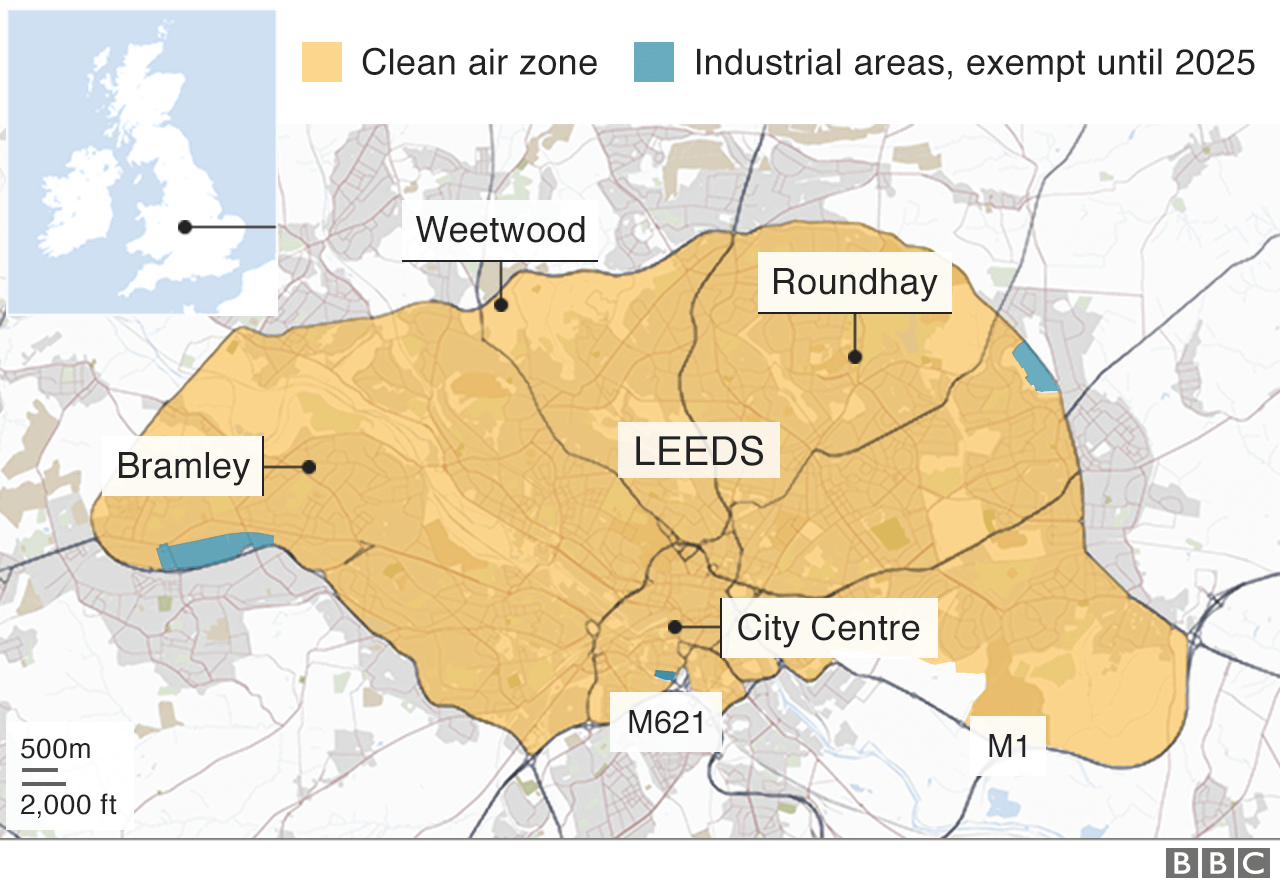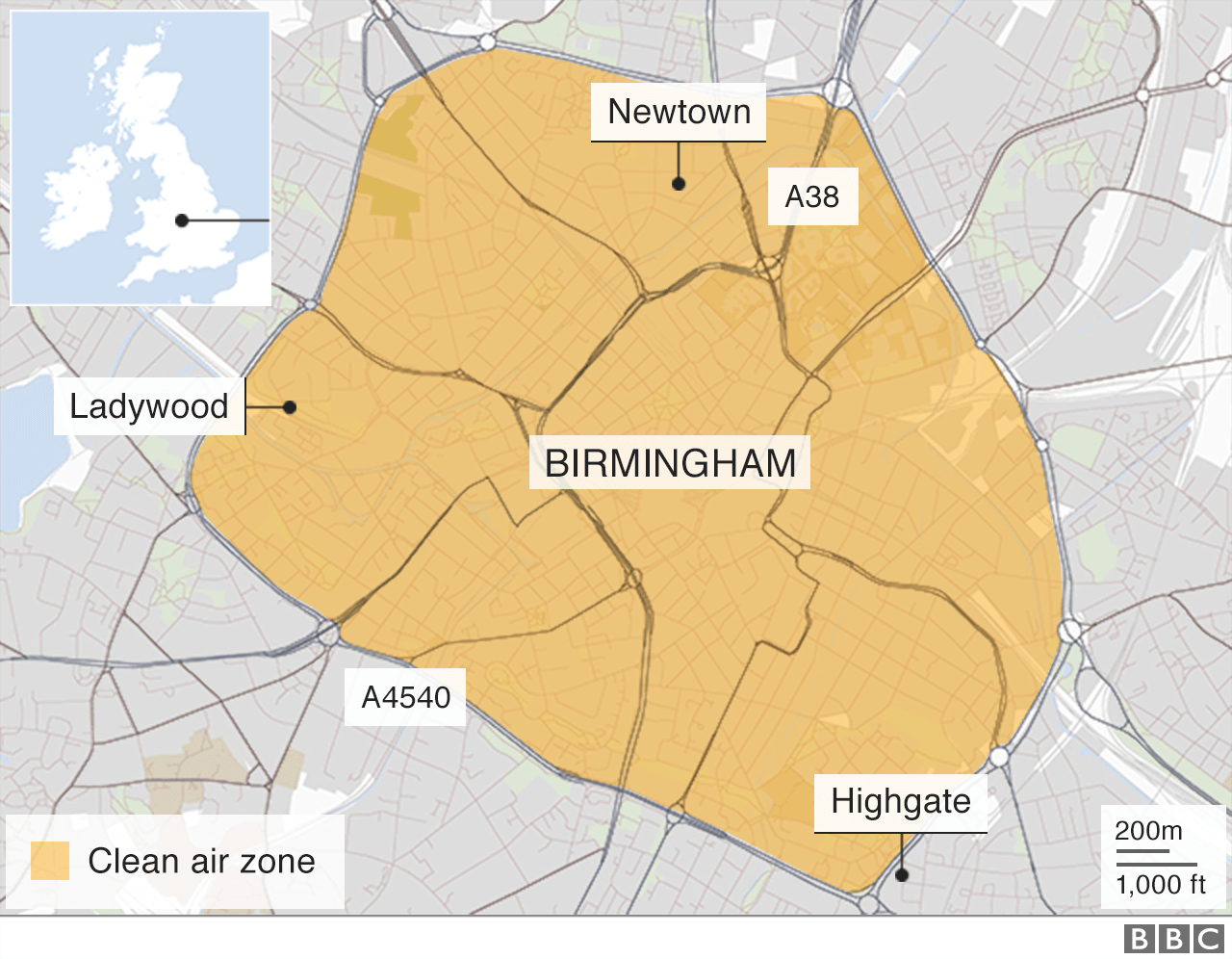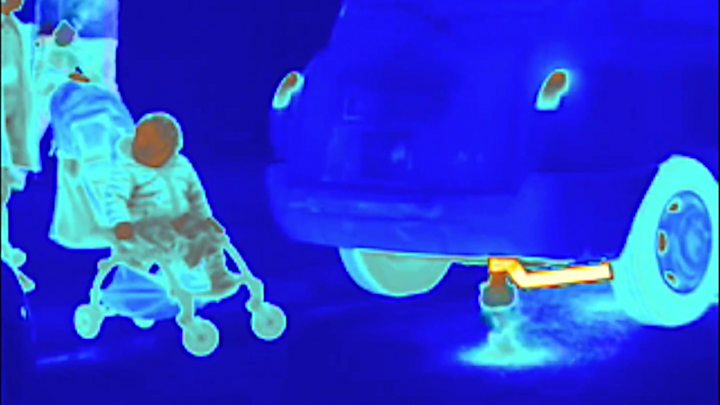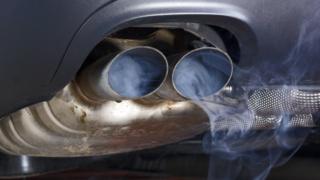
Where will UK drivers pay for polluting?
 Image copyright EPA
Image copyright EPA Drivers of the most polluting vehicles now have to pay to drive into central London – and soon other towns and cities across the UK will follow suit.
Leeds and Birmingham are set to roll out similar schemes next year, while dozens of other places are considering establishing a clean air zone (CAZ). So how will they work and where else might you soon have to pay to drive?
What are clean air zones?
Put simply, CAZs are designed to cut pollution and encourage people to drive less polluting vehicles, including electric and more modern petrol and diesels.
Drivers of the most polluting vehicles can be charged up to £100 a day to enter areas where councils believe the air to be toxic – often in town and city centres.
But there are two main types of CAZs: those that charge drivers and those where there is no charge but councils promise “action to improve air quality”.
A CAZ can be applied to all vehicles or a selection, from buses, lorries, vans, taxis, private cars, to motorcycles and mopeds.
Government guidelines state that profits should then be reinvested in local transport schemes.
Why are they being rolled out now?
The UK’s highest court, the Supreme Court, ordered ministers to take immediate action to cut air pollution in 2015.
The case was brought by environmental law organisation ClientEarth, which insisted not enough was being done after the UK breached EU limits for nitrogen dioxide (NO2) – a gas produced by diesel vehicles which can decrease lung function.
 Image copyright Getty Images
Image copyright Getty Images In response, the government called for five cities to establish a CAZ: Birmingham, Leeds, Southampton, Nottingham and Derby. This was in addition to London’s Low Emission Zone which was established in 2008.
But the government has since lost two other court cases, also brought by ClientEarth, which said the move had not gone far enough.
These resulted in the government telling 28 more councils to draw up plans to tackle NO2 levels and a further 33 to carry out “feasibility studies” on whether a CAZ was needed to reduce levels in the “shortest possible time”.
- Are diesel cars always the most harmful?
- Do clean air zones work?
- How will the petrol and diesel ban work?
The EU’s annual limit has been set at 40 micrograms of NO2 per cubic metre of air since 2010.
In 2017, 37 out of 43 areas exceeded these limits – although most (36) had recorded lower levels than in 2016.
The UK has been threatened with court action by the European Commission over its longstanding failure to meet EU limits for nitrogen dioxide.
The government says it has no plans to change limits and targets for air quality following Brexit.
But after Brexit the UK’s targets and deadlines could begin to differ from the EU’s.
Where are charging clean air zones planned?
London
The capital already had a non-charging low emission zone covering most of Greater London, but tighter emission standards were introduced for central London from 8 April, under the new Ultra Low Emission Zone (ULEZ). It is set to be expanded to cover most of Greater London from 25 October 2021.
It will charge:
- £12.50 for private cars, vans, motorcycles and mopeds
- £12.50 for taxis
- £100 for buses, coaches and HGVs
You can check if your vehicle meets the ULEZ’s emission standards by entering its registration number on the TfL website.

Separately, certain streets in Shoreditch in east London will only permit “ultra low emission vehicles”, such as electric and hydrogen vehicles, between peak hours.
Leeds
Leeds is one of two cities outside of London to have had its plans signed off by the government. It will be introduced from 6 January 2020 covering most of the city centre.

There will be:
- No charge for private cars, vans, motorcycles and mopeds
- £12.50 for taxis (or £50 per week for Leeds-licensed vehicles)
- £50 for buses, coaches and HGVs
You can check if your vehicle meets the emission standards on the city council’s website.
Birmingham
Birmingham’s plans for a charging CAZ have also been approved by Department for Environment, Food and Rural Affairs (Defra).

It will charge:
- £8 for private cars and taxis
- £50 for buses, coaches and HGVs
- Motorcycles and mopeds are expected to be exempt
The zone will be introduced from 1 January 2020 on or inside the inner ring road.
Bath
Earlier proposals to charge drivers of private cars £9 to enter the city centre have been dropped after the council received a record 8,000 responses during a public consultation.
However, other charges will be introduced from late 2020:
- £9 for for taxis
- £100 for buses, coaches and HGVs
- Free for private cars, vans, motorcycles and mopeds
Sheffield
No final decisions have been made yet. However, the council’s preferred option would see the creation of a charging CAZ in Sheffield’s inner ring-road:
- £10 a day for taxis, private hire vehicles, vans/LGVs
- £30 a day for buses, coaches and HGVs
The proposals are set to be consulted on later this year.
Greater Manchester
The proposed CAZ would cover all 10 local authority areas in Greater Manchester, introducing charges for the most polluting vehicles – excluding private cars. It would charge:
- £100 for HGVs, buses and coaches from 2021
- £7.50 for taxis and private hire vehicles from 2021
- £7.50 for vans and minibuses from 2023
Two public consultations on the plans are expected later this year.

Oxford
The council has voluntarily drawn up its own plans to reduce NO2 levels. Under the proposals, all non-zero emission vehicles would be banned during certain hours from parking and loading in the city centre.
A larger outer zone would ban any taxis and non-local buses, vans and lorries that do not meet agreed emission standards.
The council is still considering charging those who breach the rules but says no decision will be made until after a public consultation later this year.
Glasgow
Glasgow is home to Scotland’s first low-emission zone which came into force on 31 December last year. The scheme initially one in five buses entering the city centre zone must meet new emission standards. The council says that proportion is expected to increase in future years.
It will also apply to lorries, vans and private cars from December 2022. The council says emission standards for motorcycles and mopeds are still being considered.
Where are non-charging zones planned?
Southampton
Earlier plans to charge vehicles were dropped in January.
The council said it could instead meet government limits through a “refined set of freight, bus and taxi measures”.
- Southampton clean air zone plan agreed
- Pollution hotspots revealed: Check your area
- Children’s school bags monitor toxic air
York
Its proposed zone would come into force in 2020 and would apply to buses that do not meet emission standards travelling within the city’s inner ring road five or more times a day.
The council says operators that do not comply will not be able to run services in the area.
Where else are CAZs being considered?
- Bristol – It’s proposing a charge for the most polluting buses, taxis, HGVs and LGVs, but not private cars. The council wants to submit its plan to the government in September
- Derby – A final plan has not been published but two options involve the creation of a charging CAZ
- Cambridge – A study is under way on the introduction of a CAZ in central Cambridge
- Newcastle, Gateshead and North Tyneside – The councils want to explore measures other than a CAZ and have begun a public consultation on what to do next
- Cardiff – The Welsh government has produced its own framework for councils which are considering introducing CAZs
- Edinburgh, Dundee and Aberdeen -The Scottish government has said it wants low emission zones in Scotland’s biggest cities before 2020
Elsewhere
Eight other councils have been told to produce plans to tackle NO2 levels: Bolsover, Bradford, Portsmouth, Broxbourne, Newcastle-under-Lyme, Stoke-on-Trent, Leicester and Liverpool.
They have until 31 October this year to submit plans.
Fareham, Warrington, Reading and Slough are also looking into whether introducing a CAZ will help reduce NO2 levels.
Some councils have ruled out a CAZ, including Nottingham, which was one of the five cities originally told to implement one. Ministers have backed the city’s decision after the council said its research had shown a CAZ was not needed.

What are the concerns over CAZs?
Environmental campaigners, haulage firms and some taxi companies have expressed concern about how the CAZs will work.
ClientEarth lawyer Katie Nielder said despite the government’s assurances that tackling air pollution was a priority “most of its actions have been designed to dump the problem on hard-pressed local authorities”.
The Freight Transport Association says more public funds should be given to firms which will have to pay to convert many of their lorries to meet the emission standards.
 Image copyright Getty Images
Image copyright Getty Images What does the government say?
It says it’s spending £3.5bn on tackling roadside NO2 concentrations, including £220m for a new clean air fund to support individuals and businesses affected by councils’ plans to improve air quality.
Defra has set up the Joint Air Quality Unit to work with councils on developing their plans to give drivers a “quick and easy way” of making payments.
What’s next?
All new cars in the UK will be “effectively zero emission” by 2040, under further plans to tackle air pollution.
The government is under pressure to bring forward this deadline and ban all sales of new petrol and diesel cars by 2032, after a report by a parliamentary committee described its plans as “vague and unambitious”.
Read more: https://www.bbc.co.uk/news/uk-47389830

Leave a Reply